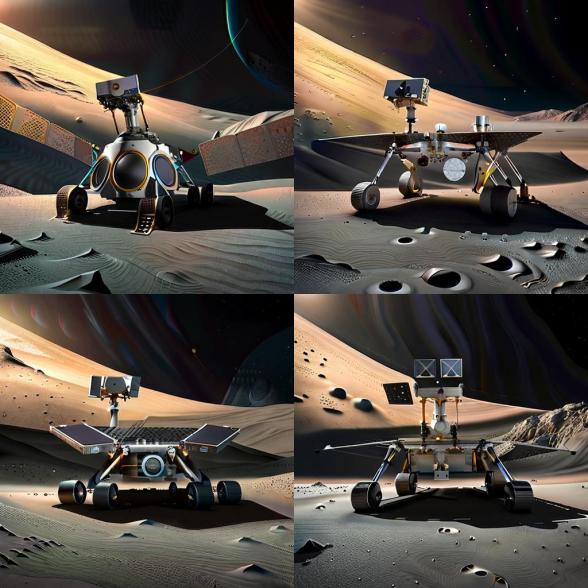Introduction
The Chandrayaan 3 mission represents an important milestone in India’s space
exploration journey. Building on the successes of its predecessors, Chandrayaan 1 and
Chandrayaan 2, this ambitious endeavor aims to further expand our understanding of
the Moon and advance technological capabilities. With a renewed focus on scientific
exploration and technological advancements, Chandrayaan 3 is set to unravel the
mysteries of our cosmic neighbor and pave the way for future space missions.
I. The Genesis of Chandrayaan
India’s foray into lunar exploration began with Chandrayaan 1, a groundbreaking
mission that marked the country’s first venture into space beyond Earth’s orbit.
Launched in 2008, Chandrayaan 1 successfully orbited the Moon and provided valuable
data on its surface composition, mineralogy, and presence of water molecules. Building
on this success, India launched Chandrayaan 2 in 2019, which included a mission to
land a rover on the lunar surface. Despite the lander’s unfortunate crash landing,
Chandrayaan 2 demonstrated India’s technical prowess and determination in the field of
space exploration.

II. Setting the Stage for Chandrayaan 3
-
Enhancing the Mission Scope and Objectives
Chandrayaan 3 aims to enhance the scientific payload and technological advancements
of its predecessors. By expanding the mission scope, it will provide researchers with a
wealth of data to further understand the Moon’s composition, geology, and potential
resources. Through this mission, India aims to elevate its place among global spacefaring nations and reinforce its commitment to scientific progress.
Collaborations and Global Partnerships
To leverage international expertise and shared endeavors, Chandrayaan 3 will forge
collaborations with other space agencies. By pooling resources and knowledge, the
mission will benefit from diverse perspectives and foster a sense of global cooperation
in the pursuit of scientific exploration

III. Crafting a Mission Blueprint
Designing the Spacecraft and its Components
The success of Chandrayaan 3 hinges on the meticulous design of its spacecraft and its
components. Upgrades to the lunar lander will enable more precise landing capabilities,
mitigating the risks associated with touchdown on the lunar surface. Additionally, the
rover’s capabilities will be enhanced to facilitate advanced scientific research and data
collection, enabling a greater understanding of the Moon’s geology and potential
resources.

Overcoming Engineering Challenges
Precision landing on the Moon’s surface presents a significant engineering challenge for
the Chandrayaan 3 mission. The spacecraft must overcome the lunar environment’s
extreme conditions, including the absence of an atmosphere and the presence of
uneven terrain. By ensuring operational resilience, the mission will withstand the
demanding lunar conditions and deliver on its scientific objectives.
IV. Cutting-Edge Technologies on Board
Advanced Scientific Instruments
Chandrayaan 3 will carry advanced scientific instruments to analyze lunar soil and rock
samples in unprecedented detail. By studying the Moon’s geology and mineralogy,
researchers can gain insights into its formation and evolution, as well as the potential
presence of valuable resources that could support future space exploration.
Artificial Intelligence and Automation
The inclusion of artificial intelligence and automation on board Chandrayaan 3 will
enable autonomous decision-making capabilities. Real-time data analysis and problemsolving algorithms will enhance the efficiency of scientific research and facilitate quick
decision-making during critical mission operations.

V. Uncovering the Moon's Mysteries
Investigating the Moon’s Water Resources
Chandrayaan 3 will probe for signs of lunar water, a crucial resource for future manned
missions and sustainable space exploration. By examining the Moon’s water resources,
scientists aim to understand its distribution, source, and potential uses. The findings
from this investigation will have significant implications for future lunar missions and the
establishment of space colonies.
Examining the Moon’s Geological Evolution
Through the study of the moon’s volcanic history, scientists can gain valuable insights
into its geological evolution. By unraveling lunar tectonics and geophysics,
Chandrayaan 3 will contribute to our broader understanding of planetary processes and
the similarities and differences between Earth and its cosmic neighbors.
VI. Chandrayaan 3's Launch and Mission Timeline
Collaborative Launch Strategies
Chandrayaan 3 will utilize existing launch capabilities to maximize efficiency and costeffectiveness. By leveraging proven launch technologies, the mission aims to ensure a
smooth journey to the Moon. Additionally, future launch options are being explored to
further enhance mission capabilities and accommodate additional scientific payloads.
Mission Timeline and Expected Milestones
The mission will unfold in several stages, including launch preparations, a lunar landing,
and rover deployment. Each milestone represents a crucial step towards achieving the
scientific objectives of Chandrayaan 3. A meticulous timeline ensures that all mission
operations are synchronized and executed with precision.

VII. Reaping the Benefits on Earth
Advancing Technological Advancements
Chandrayaan 3’s technological advancements have the potential to revolutionize space
travel and exploration. Innovations developed for the mission, such as improved landing
capabilities and autonomous decision-making systems, can be applied to future
missions to other celestial bodies, opening up new frontiers for space exploration.
Mission Timeline and Expected Milestones
Chandrayaan 3 serves as a catalyst for inspiring young minds to pursue careers in
science, technology, engineering, and mathematics (STEM). By encouraging STEM
education and research, this mission fosters the development of a skilled workforce and
ignites a passion for scientific discovery among the youth, contributing to national pride
and aspirations.

VIII. Addressing Concerns and Criticisms
Resource Allocation and Cost Considerations
Balancing priorities and financial implications is a key consideration in any space
exploration endeavor. Chandrayaan 3’s resource allocation and cost considerations
take into account the significance of the mission’s objectives, the expected scientific
outcomes, and the potential long-term benefits for India’s space industry.
Environmental Impact and Ethical Considerations
Ensuring responsible space exploration practices is paramount for Chandrayaan 3. The
mission actively works towards mitigating space debris and contamination risks to
preserve the integrity of the lunar environment. By upholding ethical standards, the
mission aims to set an example for sustainable space exploration.
IX. Summary: Chandrayaan 3's Pivotal Voyage
Chandrayaan 3 represents a significant leap forward for India’s space exploration
endeavors. With an expanded mission scope, advanced technologies, and a focus on
scientific exploration, this mission promises to unravel the moon’s mysteries and
contribute to our understanding of the cosmos. Through collaborations, global
partnerships, and impactful research, Chandrayaan 3 shapes India’s role in the global
space race, while inspiring future generations to reach for the stars.


